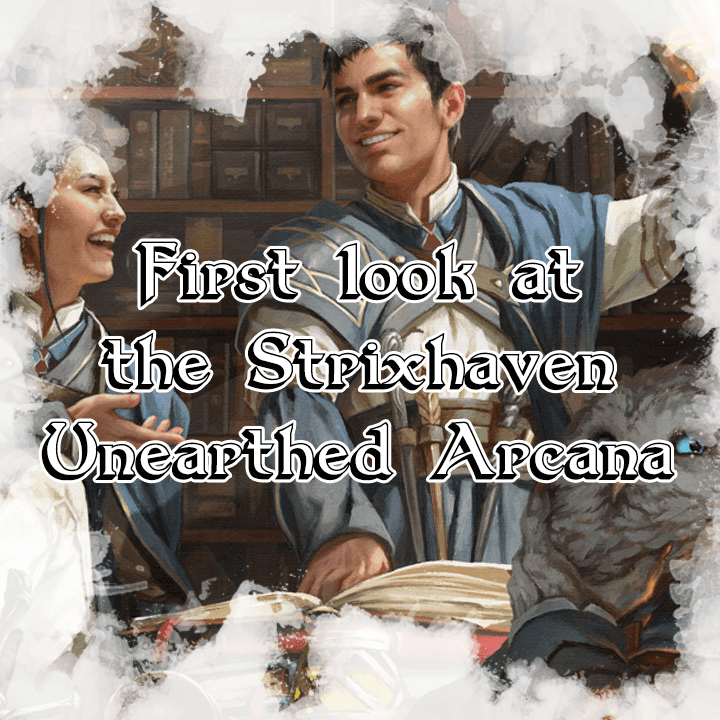Recently, Wizards announced two upcoming D&D books for this year: the Feywild-themed adventure Wild beyond the Witchlight and the Magic: The Gathering-crossover sourcebook Strixhaven: a Curriculum of Chaos. Details about Witchlight are scant, but Wizards dropped a new unearthed arcana detailing five new playtest subclasses for Strixhaven. Player characters get the opportunity to join one of five colleges: Lorehold, Prismari, Quandrix, Silverquill, and Witherbloom. However, the fascinating part is that each college is available to multiple classes, meaning you could have a bard and wizard belonging to the college of Lorehold in the same group! What does all of this mean? Let’s jump right into our First Look at the Strixhaven Unearthed Arcana!
Disclaimer: This post contains affiliate links, meaning we may receive a small commission from qualifying purchases if you click on our links, at no additional cost to you. As Amazon affiliates, we may earn from qualifying purchases. You can see our full disclosure here. Thanks for supporting your favorite dungeon artists!
All art belongs to Wizards of the Coast
First look at the Strixhaven Unearthed Arcana
What is Strixhaven?
To give some background on the newest setting, Strixhaven began as the 87th expansion for Magic: The Gathering and came out in April 2021. The setting revolves around the academy of Strixhaven: the “most elite University in the Multiverse”. Five colleges make up the academy, each with its own history, magical specialities, logo, and even mascots. Those colleges are:
Lorehold
Enthusiastic adventurers and academics who excel in exploration and understanding the forces that underlie and drive history. It’s like if Gryffindor went full jock-mode.


Prismari
Artistically-driven mages that harness elemental energy to create spellcasting masterpieces of expression and emotion. I bet it’s not a challenge for these art kids to find funding for their projects.
Quandrix
Wizards that see mathematical formulae in all things, and warp reality based on equations. If the math club ever became magic-users, they’d join Quandrix.


Silverquill
Sorcerers who specialize in magic powered by their voice, whether it is song, poetry, or carefully-crafted insults. Only fools and drunks try to debate a Silverquill student.
Witherbloom
Spellcasters with a knack for compelling nature towards their needs, either by empowering or exploiting it. Whatever you do, just don’t ask where they get their fertilizer.

The Subclasses
So enough about the background and setting, what do these college-based subclasses even do? Since these subclasses cover a lot of ground, I’ll break things down by college.
Lorehold
For the starting college in my first look at the Strixhaven Unearthed Arcana we’ve got Lorehold! This subclass is available to Bards, Warlocks and Wizards. At first level they receive the cantrip sacred flame as well as the 1st-level spell comprehend languages that doesn’t count towards the classes’ known spells. In addition, they also receive two spells at certain level thresholds:

- 3rd — knock, locate object
- 5th — speak with dead, spirit guardians
- 7th — arcane eye, stone shape
- 9th — destructive wave, legend lore
Since history fascinates the students of Lorehold, their main feature is Ancient Companion. This allows them to summon a statue familiar upon finishing a short or long rest and animate it with one of three types of spirits: healer, sage, or warrior. Each spirit confers a different buff to the familiar and offers quite a bit of versatility for the player.
Lorehold characters gain Lessons of the Past at 6th level, which grants a much stronger buff to each of the ancient companion spirit types.
War Echoes becomes available at 10th level, and allows characters to cause targets to become vulnerable to a type of damage that the Lorehold player uses. For example, casting war echoes while an ally strikes with a slashing weapon causes the target to take double damage, as long as they fail their save against the ability.
History’s Whims is the final feature at 14th level, allowing characters to enter a “state of chronal chaos” to gain one of three benefits that cycle each round for 1 minute.
The college of Lorehold jumps right out of the gate with some outstanding features, chief among them is the sidekick ancient companion. Characters that gain lessons of the past get some great buffs to the companion as mentioned, but the one I’m hyped about is the Warrior benefit: “If you use your action to cast a cantrip, you can make one weapon attack as part of that action. If that weapon attack hits, the target takes an additional 1d8 radiant damage.” My first reaction upon reading this was “True strike is finally useful”! I kid, though I love the idea of casting true strike, making an attack with a ranged weapon to get that sweet, sweet extra damage, then next turn getting advantage and possibly chaining more cantrips. My bet is that this feature will get nerfed during testing. This subclass reminds me of the Battle smith Artificer’s robot companion, but with way more versatility. Not to bury the lede, but this might already be one of my favorite of the newest subclasses!
Prismari
Next up we’ve got the art kids. The college of Prismari is available to druids, sorcerers, and wizards. Rather than getting a list of spells like Lorehold, Prismari mages receive Creative Skills, which nets them proficiency in two of four skills, and Kinetic Artistry. This is the bread-and-butter feature that allows characters to dash as a bonus action, but each time a character does so, they can gain one of three additional effects.

At 6th level Prismari receive Favored Medium. This feature grants resistance to one of three damage types (cold, fire or lightning), but when casting a spell that deals the chosen damage type, you extend a “spectacular aura of artistry” in a five foot radius. While active, creatures of your choice inside this radius also gain the chosen damage resistance. This damage type can also be swapped after a long rest.
10th level Prismari mages get the Focused Expression feature, which expands on the damage types in the Favored Medium feature: Cold spells gain an extra 1d6 damage plus a chance to slow movement speed; Fire increases damage dealt but also grants 1d6 temporary hit points to an ally within 30 feet, and Lightning causes targets to lose reactions on top of more damage.
Finally, Impeccable Physicality is the 14th level feature that grants proficiency on dexterity saving throws if not already owned, and it also treats a roll of 9 or lower on dex saves as 10 instead.
This subclass didn’t impress me upon my initial readthrough. Something about the main ability tied to dashing didn’t strike me as particularly useful. As I re-read the feature for this review it dawned on me that it can drastically improve movement options for rather sluggish classes (I’m looking at you, wizard). Using the lightning-based thunderlight jaunt ability allows characters to move without incurring attacks of opportunity, which is pretty good for squishy spellcasters who either get too close or get surprised in close quarters. I also like the idea of a druid wildshaping into a badger and burning everything in its path! However, I feel that the last feature is a bit of a letdown, especially if the character already has dex save proficiency. I think it would do better as an earlier feature, or even one gained at 1st level, and increase the power of Focused Expression. All that said, I could see myself trying out a Prismari character, though they may not be my first pick.
Quandrix
Let’s give it up for the math nerds! Only sorcerers and wizards may join Quandrix (not surprising), and they have similar feature loadouts to the Lorehold. Level one grants the cantrip guidance and 1st-level spell guiding bolt. More spells are obtained automatically at subsequent levels:

- 3rd — enlarge/reduce, spike growth
- 5th — aura of vitality, haste
- 7th — control water, freedom of movement
- 9th — circle of power, passwall
In addition to the spells, the Quandrix also receive the Functions of Probability feature, which grants one of two special effects when targeting a creature with a spell. There’s Diminishing Function, which forces a bane-like effect, and Supplemental Function, which works like bless. Unlike bless and bane, the die rolled for these is a d6, rather than a d4. This seems like a pretty handy ability considering it works after using a spell slot.
Level 6 sees Velocity Shift, which grants a feature that can potentially teleport a creature if they get too close. This would be a good one to drop bad guys off of cliffs or get allies out of harm’s way.
The Null Equation feature is unlocked at 10th level. Once per turn after dealing damage, you force a creature to make a Con save, where failure causes them to have disadvantage on strength and dexterity saves, plus half weapon damage.
Coming in at level 14 is the Quantum Tunneling feature. This allows characters to gain resistance to bludgeoning, piercing, and slashing damage, but it is also a frankly baffling movement option. This movement allows characters to move through creatures and objects as if they were difficult terrain, but you take 1d10 force damage for every five feet you move while inside another creature or object. Sure, this allows you to move through opponents, but the damage you would take doesn’t seem like a great trade off, especially when you consider the existence of both the passwall spell and Velocity Shift.
Overall, I think the Quandrix subclass has some acceptable features. Some could be helpful in combat, but they don’t build off each other like the previous subclasses. I honestly think Quantum Tunnelling is the weakest feature so far, and I wouldn’t be surprised if it gets retooled before release.
Silverquill
We’re getting to the debate club with Silverquill! Bards, warlocks and wizards can take the subclass, which grants them Eloquent Appearance and Silvery Barbs. The first gives characters a choice of cantrips between sacred flame or vicious mockery on top of two skill proficiencies. The second feature gives characters a reaction to demoralize creatures after they succeed on an attack, skill check, or saving throw. This means the creature rerolls the d20 and must use the lower roll. If that new roll causes the attack/check/save to fail, then the player can pick another creature (preferably an ally) that can now reroll one attack/check/save for one minute. As powerful as this seems, it can only be used once before needing a long rest or expending a spell slot.

Inky Shroud is the 6th level feature that gives characters the darkness spell, but it can be cast once without using a spell slot. But that’s not all! When darkness is cast this way, the character can see through it, and any creature that begins their turn within the magical darkness receives 2d10 psychic damage.
At 10th level the Silverquill receive Infusion of Eloquence. This feature allows players to change the damage type of a spell to either psychic or radiant. When done this way, the creature takes extra damage equal to the character’s proficiency bonus and it receives one of two conditions:
- Psychic. The creature is frightened of you until the start of your next turn.
- Radiant. The creature is charmed by you until the start of your next turn.
14th level unlocks the Word of Power feature, which grants two options:
- Deadly Despair. When the target of your Silvery Barbs fails an attack roll, an ability check, or a saving throw because of the reroll, you can invoke a word of despair to give the target vulnerability to one damage type of your choice until the start of your next turn.
- Selfless Invocation. When a creature you can see within 60 feet of you takes damage, you can invoke a word of power using your reaction to grant the creature resistance to that damage, and you take an amount of psychic damage equal to the damage that creature takes.
This subclass strikes me as the most spell-slot dependent one so far, but that’s not a bad thing. Between Silvery Barbs, Inky Shroud, and Infusion of Eloquence, there’s plenty of options for crafty spellcasters to turn a fight to their advantage. I particularly like Inky Shroud as both crowd control and a damage dealing spell.
Witherbloom
For the final subclass in my first look at the Strixhaven Unearthed Arcana, we reach the college where the 4H club decides to be necromancers! Only druids and warlocks can become Witherbloom students, but much like Lorehold and Quandrix, they receive a selection of spells at certain levels:

- 3rd — lesser restoration, ray of enfeeblement
- 5th — revivify, vampiric touch
- 7th — blight, greater restoration
- 9th — antilife shell, mass cure wounds
Not only that, but they get the feature Essence Tap. When activated as a bonus action, this feature confers one of two benefits for one minute:
- Overgrowth. As a bonus action on subsequent turns while the benefit lasts, you can expend and roll one Hit Die. You regain a number of hit points equal to the number rolled plus your spellcasting ability modifier.
- Withering Strike. When you deal damage, you can change the damage type to necrotic, and you ignore resistance to necrotic damage.
Witherbloom Brew is the 6th level feature, which gives proficiency with herbalism kits. It also grants the ability to create a number of magical brews at the end of a long rest.
When Witherblooms hit level 10, they get Witherbloom Adept. Once per turn when you deal necrotic damage or restore hit points using a spell, one target of the spell takes additional damage or regains additional hit points equal to your proficiency bonus.
Finally, we finish out Witherbloom with Withering Vortex. When casting a spell that deals necrotic damage, you can drain the lifeforce from one of the creatures (provided they aren’t undead or a construct). Not only that, but one other creature (like the beefy barbarian) regains an amount of hit points equal to the life energy drained!
Witherbloom really gives Lorehold a good fight for being number one on my list! There’s so much synergy with the necrotic resistance-ignoring Essence Tap, Witherbloom Adept, and Withering Vortex. The real “cherry on top” is Witherbloom Brew, which could add three uses of a potion of healing/lesser restoration hybrid. I feel that this subclass really challenges some of the more dedicated “healer” classes with all of the features and included spells.
Wrap up / Thoughts and opinions
That’s my overall First look at the Strixhaven Unearthed Arcana! On the whole I feel like these are some great additions to D&D. One thing that does seem odd to me is the cross-class subclasses. It works great across most classes except the bard, who miss out on gaining all of the subclass features due to them only receiving two Bard College features. Bards have to choose if they want the 10th level feature or the 14th once they hit 14. I guess I never noticed Bards only get two subclass features, but it seems weird they get one less than other classes.
How would I rank all of the subclasses? I don’t think it’s any secret that I really like Lorehold and Witherbloom, and I am eager to roll up some tester characters to see how they fare in battle. Without further ado, I would rank these subclasses:
- Lorehold
- Witherbloom
- Silverquill
- Prismari
- Quandrix
Subclasses with features that build off each other as characters level up really speak to me. Both Lorehold and Witherbloom almost seem too good upon first inspection, leading me to believe there’ll be some changes to even them out on final release. Silverquill gets third thanks to its’ feature interplay, though it doesn’t sit as high since most of the features only get one use before needing a long rest or expending a spell slot. Prismari is excellent in the right circumstances, but there’s a lot of setup needed to make those features work. Not to mention Impeccable Physicality isn’t quite a top-tier 14th level feature. I could see people multiclassing into Prismari and only going so far as to get Focused Expression.
Finally, while the others need a little bit of love here and there, Quandrix is the main subclass that needs serious fine-tuning. I just can’t get over how uneven Quantum Tunnelling feels as written. I think an ability that deals self-damage as you use it feels less like a feature and more of a penalty.
Overall, I’m pretty excited about this book! I wasn’t too interested in the last MtG/D&D crossover book, but I think I’ll give this one a try. I hope you enjoyed our first look at the Strixhaven Unearthed Arcana, and if you agree (or disagree) with my impressions, let us know on Twitter, Facebook, Instagram, or Discord! If you’d like access to more maps and content, including downloadable PDFs of our adventures, check out our Patreon. We’re able to do what we do because of all our amazing Patrons!







